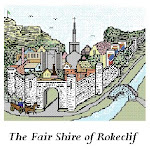As Published in the White Birch newsletter
Rokeclif, Northshield, October 2008
Rokeclif, Northshield, October 2008
At some point amidst attending shire meetings, helping at events and enjoying A&S gatherings each of us tackles the challenge of creating a persona. For some it’s a simple matter selecting a name they like, maybe a time and a place, and calling it good. They aren’t looking to root it into a grander picture or to delve too deeply into the matter. For others of us though the concept of a persona is a daunting challenge, our desire to bring a medieval character fully to life hampered by a lack of knowledge or even an idea of where to begin. To this SCAdian I would hand two books: The Timetables of History by Bernard Grun and The Illustrated Book of Heraldry by Stephen Slater.
The first, The Timetables of History, is not a standard book one reads cover to cover or a chapter at a time. Rather, it is a chart more than 600 pages long charting events of human history. The spectrum covered includes politics, literature, music, science and daily life. If one is at a loss for an inspiring year or wants to have a better idea of what occurred in their persona’s lifetime, this is an ideal starting point. The facts are brief and the format is logical. Many time tables I’ve seen divide their lists by culture or continent and run the various strands parallel to each other. This book places worldwide events together, separating them out only by year and subject. Rather than be a confusing muddle it allows the lengthy chart to retain its simple and easy to use format.
The very length of Timetables is something of a drawback; only about one third of the book is applicable to SCAdian needs. The data is not interpreted, sources are not listed due to the enormity of space such would require, and this book alone will not complete a persona story. Its true value is in the sparking of ideas and confirming of facts, both especially useful functions to new SCAdians.
The second book, The Illustrated Book of Heraldry is a solid introduction to heraldry at large. It may be read cover to cover if one wishes or certain chapters of interest may be read in isolation. The three foci of the book are the history, language and use of heraldry. Such are of course very broad subjects in and of themselves but this title serves as a general over view, excellent for someone with little or no prior knowledge. The layout is bold, easy to read and quite attractive with many color pictures to clearly illuminate what is spoken of in the text.
As a general reference book, Heraldry does not stay within SCA bounds, either of time or of our heraldic rules. As well as the history of heraldry, this book does spend some time on modern heraldry in both its design and its uses. The SCA maintains its own set of heraldic rules, exceptions and guidelines that this source, of course, does not cover. It is however a solid start to a beautiful subject and, as long as its limitations are kept in mind, a wonderful resource when first pondering the design of one’s own SCAdian arms.


No comments:
Post a Comment